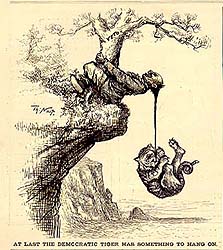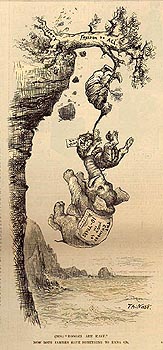

The first piece of proposed legislation relating to Chinese immigrants appeared in 1852 in the form of Senator Tingley's Coolie bill which would have enforced the contracts made in China that brought laborers over for a determined number of years. While this proposal did not become legislation--and, in fact, it wouldn't have effected many immigrants in America to begin with--the opposition it generated introduced many of the anti-Chinese arguments that would be heard for years to come.

|
This Coolie bill was perceived as a blatant attempt to encourage the introduction of
cheap immigrant labor into the United States, thus undermining white laborers' desire
to make better wages. Also, as Senator Roach argued, the bill would allow for at least
half a million Chinese criminals to enter the United States as contract laborers.
One element contributing to the nativist fears was the way in which the Chinese Six Companies seemed to serve as a go-between for many citizens in Chinatown. This belief is contradictary to the fact that many of these self-help organizations rose out of the fact that the government did not view these immigrants as legal citizens with certain inalienable rights.
|
Additional material which seemed to support the argument that many of the Chinese immigrants were coolies came from the erroneous claims of Consul D.H. Bailey who was stationed in Hong Kong from 1871-1879 and reported on the Coolie Trade. Without a grasp of the Chinese language, it seems Bailey repeatedly failed to differentiate between free emigration and contract labor. That, however, did not limit the far-reaching impact of his statements.
President Grant's Message of 1874 questioned whether Chinese immigrants came to America voluntarily. In 1876, a committee in the California legislature relied heavily on Bailey's report to determine that there were a number of Chinese in California who were in labor contracts. A Congressional Committee then came to a similar conclusion even though twelve of the fourteen witnesses who testified before them said that they believed there were no such labor contracts in effect in California.
| Fear of Chinese immigrants taking over jobs was coupled by a growing concern over
the criminal element. While there was certainly a criminal factor in place--as seen in
the "tongs"--fear of such an element was grossly exaggerated.
A 1909 study on Chinese Immigration notes: "The Chinese became the scape-goats for the evils of the time; they were stoned, robbed, maltreated in the streets with impunity by the idler and the hoodlum, who suffered no restraint."
This scape-goating is exemplified in legislative action of the time. In 1854, the Committee on Vice and Immorality linked anti-Chinese sentiment with a decrease in gambling and increases in Temperance, Sunday-School attendance and refined society. It seems that taking out frustrations on immigrants who didn't have any legal right to protest was good for building moral character.
|

|
During their entire settlement in California they have never adapted themselves to our habits, mode of dress, or our educational system, have never learned the sanctity of an oath, never desired to become citizens, or to perform the duties of citizenship, never discovered the difference between right and wrong, never ceased the worship of their idol gods, or advanced a step beyond the traditions of their native hive. Impregnable to all the influences of our Anglo-Saxon life, they remain the same stolid Asiatics that have floated on the rivers and slavedin the fields of China for thirty centuries of time.

|
These arguments were debated in Congress for almost five years before the Chinese
Exclusion Act was ratified and signed by President Hayes. This bill suspended
immigration of Chinese laborers under penalty of imprisonment and deportation.
The labor parties had succeeded in getting what they viewed as relief from unfair labor practices. Now, they had an opportunity to compete for jobs freely and effectively. At least until they saw the need to restrict the immigration of Asian Indians, Filipinos, and Japanese in the early twentieth century. . . .
|
